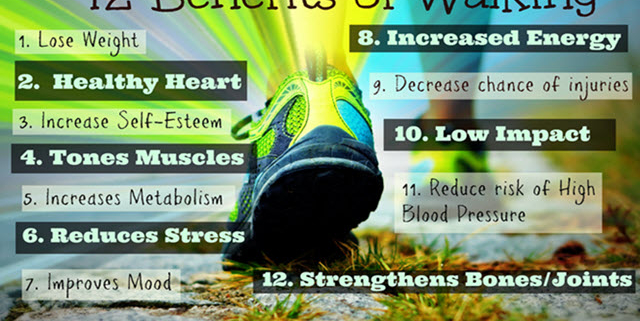Benefits of walking
Recent survey results showed that an estimated 80% of American and British people aged between 25 and 64 don’t get enough weekly exercise to meet government recommended levels of daily activity. Although fitness seems to be on the rise as more people are doing some form of exercise, most adults find it difficult to manage doing both strength and aerobic exercise.
Those who decide to improve their health with exercise often dismiss walking as not enough to lose weight and gain fitness. Fact is, walking is the oldest human physical activity, provide excellent benefits and cost very little.
When you make that decision to get off the couch or out from behind the desk, walking is a great way to start and feel and see your daily progress. Walking burns calories and speeds up your metabolism without wearing down your joints and can benefit your health in various ways.
The London School of Economics and Political Science’s recent study found walking as one of the best exercises to fight weight gain, even more so that going to a gym. Over thirteen years, the study considered the effects of various workouts on health markers in over 50,000 adults and found walkers to be slimmer than regular gym goers and those who only does high- intensity workouts. Dozens of studies prior done before have shown that daily walking keep people feeling younger, happier and healthier.
A brisk 30 minute daily walk has been linked to having a lower body mass index and smaller waistline compared to non-walkers and were particularly noticeable in three population areas who struggle with their weight, those over 50, women and low income earners.
Walking has since the beginning of time, unintentionally, helped people control their body weight and boost their longevity. The 1990’s saw the start of intentional walking to lose weight and fight certain diseases, gaining traction when the Centers for Disease Control in partnership with the American College of Sports Medicine first recommended at least 30 minutes of “brisk walking” for all adults most days of the week. The American Heart Association also got on board with the “30 minutes of walking daily” message and since then walking became the gold standard for meeting the guidelines of daily “moderate-intensity physical activity,” do-able at any time, by virtually anyone at little or no cost.
Over the years, walking has been linked to protection against certain conditions and diseases, including:
Obesity
Heart disease, hypertension, coronary artery disease
Diabetes
Depression and anxiety disorders
Dementia, Alzheimer’s and cognitive decline
Arthritis
Hormonal imbalances
PMS symptoms
Thyroid disorders
Fatigue and low energy levels
6 Health Benefits of Walking
- Helps Maintain a Healthy Weight
Walking is just as effective and perhaps more in some instances, than more intense workouts in terms of weight loss and maintenance. Walking at a brisk pace uses a good amount of energy with the added advantage that it’s an easy exercise to keep up with, has less chance of causing injury and won’t leave you exhausted compared to more intense workouts.
- Low-Impact and Easy on Joints
Walking is one of the safest forms of exercise there is and can help fight chronic disease. Everyone, including obese adults, the elderly and those with existing conditions like diabetes, heart disease and arthritis will benefit.
Regular walking supports joints with improved circulation which helps the lymphatic system to do its job, i.e. flushing toxins out of the body and lowering inflammation. Joint cartilage has no direct blood supply but the more you move, the more your synovial joint fluid circulates, allowing oxygen and nutrients to delicate or injured areas. Whether you have or had injuries in the past or not, it’s always best to start with a warm up stretch and steady, slow walk with a rest and stretch in between if needed. Pick up the pace once you feel confident to do so
- Good for Improving and Preserving Heart Health
A study published in the American Journal of Preventative Medicine in 2013 found that a brisk walk has beneficial effects on resting heart rate, blood pressure, exercise capacity, maximal oxygen consumption and quality of life. Furthermore it showed that patients with various diseases had significant benefits, such as protection from heart attacks, strokes or coronary heart disease.
The golden standard – a daily brisk 30 minute walk – is considered a simple, safe and effective form of exercise for everyone, including older people, those with a history of disease or have previous injuries excluding them from high-intensity workouts. For more heart-healthy benefits, try to gradually increase your total walking time, distance, frequency, pace and energy expenditure.
- Fights Depression And Improves Mood
All exercise, including walking are beneficial for depression and mood related problems. Commonly known as ‘’runners high’’ all forms of exercise release natural ‘feel good’ hormones in the brain, including endorphins. Walking barefoot in the sand or grass in direct contact with the earth, soaking up some sun is another easy way to feel happier.
A study done by the University of California San Francisco found that walking is associated with longevity while a study from the same department followed 6,000 women over the age of 65 found that walking 2.5 miles per day resulted in significantly more protection from memory loss than walking less than a half-mile per week.
- Supports Bone Health Into Older Age
As with other types of exercise, walking regularly can help stop the loss of bone mass (porous bone disease) with age. By walking, you are effectively fighting against gravity, forces the bones to become stronger to continue supporting your body weight which reduces the risk for fractures or osteoporosis a common disease in the elderly.
A study done by Brigham and Women’s Hospital found that postmenopausal women who walked for 30 minutes a day reduced their risk of hip fractures by 40 percent.
- Can Be Done Anywhere and Doesn’t Require Equipment
Simple, effective and free – that’s the beauty of walking. Step out of your door and away you go. If you can’t manage 30 minutes in one go for whatever reason, make it up during the day by taking shorter walks with the aim of meeting your goal of 30 or 60 minutes, when you’re ready to go further. Every walk will contribute to better muscular, heart and hormonal functioning.
Educate Inspire Change.

 no
no no
no no
no